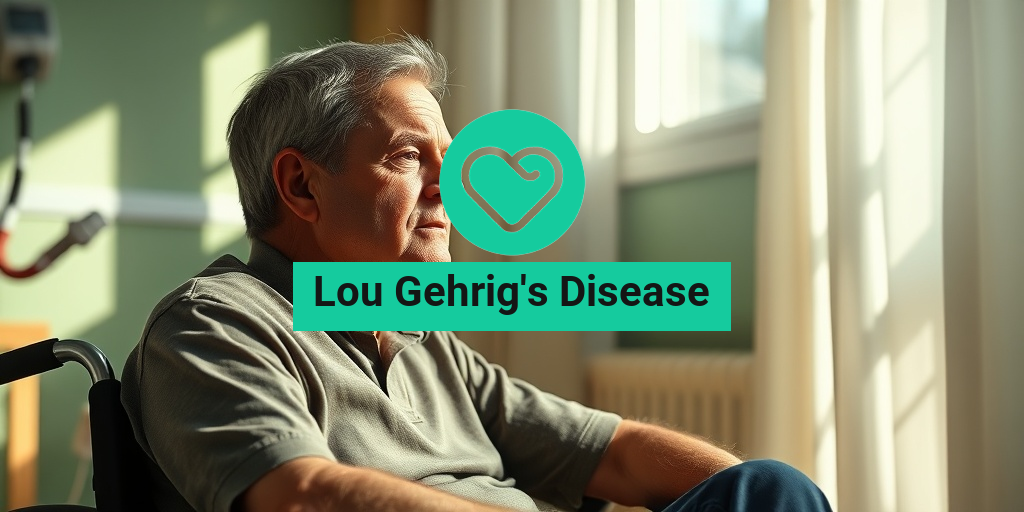What Is Lou Gehrig’s Disease?
Lou Gehrig’s Disease, medically known as Amyotrophic Lateral Sclerosis (ALS), is a progressive neurodegenerative disorder that affects the motor neurons in the brain and spinal cord. Named after the famous baseball player Lou Gehrig, who was diagnosed with the condition in the 1930s, this disease leads to the gradual degeneration and death of motor neurons, which are responsible for controlling voluntary muscle movements.
As the disease progresses, individuals with ALS experience increasing muscle weakness and atrophy, ultimately impacting their ability to speak, swallow, and breathe. While the exact cause of ALS remains largely unknown, researchers believe that a combination of genetic and environmental factors may contribute to its onset.
Understanding the Types of ALS
ALS can be categorized into two main types:
- Sporadic ALS: This is the most common form, accounting for about 90-95% of cases. It typically occurs without any known family history of the disease.
- Familial ALS: This hereditary form accounts for 5-10% of cases and is caused by genetic mutations passed down through families.
Regardless of the type, the impact of Lou Gehrig’s Disease on individuals and their families can be profound, making awareness and understanding crucial for support and care.
ALS Symptoms
The symptoms of Lou Gehrig’s Disease can vary significantly from person to person, but they generally begin subtly and worsen over time. Early symptoms may be mistaken for other conditions, which can delay diagnosis. Here are some common early symptoms of ALS:
Early Symptoms of ALS
- Muscle Weakness: One of the first signs is often a noticeable weakness in the hands, arms, legs, or feet. This may manifest as difficulty holding objects or walking.
- Muscle Cramps and Twitches: Involuntary muscle contractions, known as fasciculations, can occur, often accompanied by cramps.
- Speech Changes: Individuals may notice slurred speech or difficulty articulating words, which can be frustrating and alarming.
- Difficulty Swallowing: As the disease progresses, swallowing can become challenging, leading to choking or aspiration.
Progressive Symptoms of ALS
As Lou Gehrig’s Disease advances, symptoms become more pronounced and can include:
- Increased Muscle Weakness: The weakness spreads to other parts of the body, making everyday tasks increasingly difficult.
- Respiratory Issues: Weakness in the respiratory muscles can lead to breathing difficulties, requiring assistance or mechanical ventilation in advanced stages.
- Emotional Changes: Many individuals experience emotional lability, which can cause sudden mood swings or uncontrollable laughter and crying.
Diagnosis and Treatment Options
Diagnosing ALS can be challenging due to the overlap of symptoms with other neurological disorders. A comprehensive evaluation typically includes a detailed medical history, neurological examinations, and various tests such as electromyography (EMG) and magnetic resonance imaging (MRI).
While there is currently no cure for Lou Gehrig’s Disease, treatments focus on managing symptoms and improving quality of life. Medications like riluzole can slow disease progression, while physical therapy, occupational therapy, and speech therapy can help maintain function and independence for as long as possible.
For those seeking more information and support regarding ALS, resources like Yesil Health AI (yesilhealth.com) offer evidence-based health answers and guidance.
In conclusion, understanding Lou Gehrig’s Disease and its symptoms is vital for early detection and management. If you or someone you know is experiencing symptoms associated with ALS, it is essential to consult a healthcare professional for a thorough evaluation and support.

Causes of ALS
Lou Gehrig’s Disease, medically known as Amyotrophic Lateral Sclerosis (ALS), is a progressive neurodegenerative disorder that affects nerve cells in the brain and spinal cord. Understanding the causes of ALS is crucial for both patients and their families as they navigate this challenging diagnosis.
Genetic Factors
Research indicates that approximately 5-10% of ALS cases are familial, meaning they are inherited through genetic mutations. The most common genes associated with familial ALS include:
- SOD1 (Superoxide Dismutase 1)
- FUS (Fused in Sarcoma)
- TBK1 (TANK-binding kinase 1)
- C9orf72 (Chromosome 9 open reading frame 72)
These genetic mutations can disrupt normal cellular functions, leading to the death of motor neurons. However, the majority of ALS cases are sporadic, meaning they occur without a clear family history.
Environmental Factors
While the exact cause of sporadic ALS remains elusive, several environmental factors have been suggested to play a role in its development. Some of these include:
- Exposure to toxins: Chemicals such as pesticides and heavy metals may increase the risk of developing ALS.
- Physical trauma: Some studies suggest that individuals with a history of head injuries may have a higher risk of ALS.
- Occupational hazards: Certain professions, particularly those involving manual labor or exposure to chemicals, have been linked to a higher incidence of ALS.
Although these factors may contribute to the onset of ALS, it is essential to note that not everyone exposed to these risks will develop the disease. The interplay between genetics and environment is complex and still under investigation.
Other Potential Causes
Researchers are also exploring other potential causes of ALS, including:
- Inflammation: Chronic inflammation in the nervous system may contribute to motor neuron degeneration.
- Viral infections: Some studies have suggested that certain viral infections could trigger ALS in genetically susceptible individuals.
- Glutamate toxicity: An excess of glutamate, a neurotransmitter, may lead to nerve cell damage.
While these factors are being studied, definitive conclusions about their role in causing ALS have yet to be established.
Risks and Risk Factors
Understanding the risks and risk factors associated with Lou Gehrig’s Disease can help in early detection and management of the condition. Here are some key factors to consider:
Age and Gender
ALS can affect individuals of any age, but it is most commonly diagnosed between the ages of 40 and 70. Additionally, men are more likely to develop ALS than women, although the reasons for this disparity are not entirely understood.
Genetic Predisposition
As mentioned earlier, a family history of ALS significantly increases the risk of developing the disease. If a close relative has been diagnosed with familial ALS, the risk of developing the condition is higher due to inherited genetic mutations.
Environmental Exposures
Individuals exposed to certain environmental factors may have an increased risk of ALS. These include:
- Military service: Veterans, particularly those who served in the Gulf War, have been found to have a higher incidence of ALS.
- Occupational exposure: Jobs that involve exposure to heavy metals, pesticides, or other toxins may elevate the risk.
Other Health Conditions
Some studies suggest that individuals with certain health conditions, such as smoking or diabetes, may have a higher risk of developing ALS. Smoking, in particular, has been consistently linked to an increased risk of the disease.
Physical Activity
Interestingly, while regular physical activity is generally beneficial for health, some research indicates that intense physical activity may be associated with a higher risk of ALS. Athletes, especially those involved in contact sports, may be at a greater risk due to repeated trauma to the nervous system.
In conclusion, while the exact causes of Lou Gehrig’s Disease remain unclear, understanding the various risks and risk factors can empower individuals and families to seek early intervention and support. Ongoing research continues to shed light on this complex disease, offering hope for better treatments and outcomes in the future. 🌟

Diagnosing ALS
Diagnosing Lou Gehrig’s Disease, also known as Amyotrophic Lateral Sclerosis (ALS), can be a complex process. This neurodegenerative condition affects the motor neurons in the brain and spinal cord, leading to progressive muscle weakness and atrophy. Early diagnosis is crucial for managing symptoms and improving quality of life.
Understanding the Symptoms
The first step in diagnosing ALS is recognizing its symptoms. Common early symptoms include:
- Muscle Weakness: This may start in the hands, feet, or legs, making it difficult to perform daily tasks.
- Muscle Cramps and Twitches: Patients often experience involuntary muscle contractions.
- Speech and Swallowing Difficulties: As the disease progresses, communication and eating can become challenging.
- Fatigue: A general sense of tiredness can be prevalent, impacting overall energy levels.
These symptoms can vary significantly from person to person, which can complicate the diagnosis. It’s essential for individuals experiencing these signs to consult a healthcare professional.
Diagnostic Tests and Procedures
Once symptoms are reported, a healthcare provider will conduct a thorough evaluation. This may include:
- Neurological Examination: A detailed assessment of muscle strength, coordination, and reflexes.
- Electromyography (EMG): This test measures the electrical activity of muscles and can help identify nerve or muscle damage.
- Nerve Conduction Studies: These tests evaluate how well electrical signals travel through the nerves.
- Magnetic Resonance Imaging (MRI): An MRI can rule out other conditions that may mimic ALS symptoms.
- Blood and Urine Tests: These tests help exclude other diseases and conditions.
Diagnosing Lou Gehrig’s Disease often requires a multidisciplinary approach, involving neurologists and other specialists. It’s important to note that there is no single test for ALS; rather, the diagnosis is made based on clinical findings and the exclusion of other conditions.
ALS Treatment Options
While there is currently no cure for Lou Gehrig’s Disease, various treatment options can help manage symptoms and improve the quality of life for those affected. The treatment plan is often tailored to the individual’s needs and may involve a combination of therapies.
Medications
Several medications are available to help manage symptoms of ALS:
- Riluzole: This medication can slow the progression of the disease and prolong survival in some patients.
- Edaravone: Approved for use in some countries, this drug may help slow the decline in physical function.
- Pain Management: Medications such as opioids or non-steroidal anti-inflammatory drugs (NSAIDs) can help alleviate discomfort.
Therapies
In addition to medications, various therapies can support individuals with ALS:
- Physical Therapy: Helps maintain mobility and reduce muscle stiffness.
- Occupational Therapy: Assists in adapting daily activities and improving independence.
- Speech Therapy: Aids in communication and swallowing difficulties.
Nutritional Support
Maintaining proper nutrition is vital for individuals with ALS. As swallowing becomes more challenging, dietary adjustments may be necessary. Working with a nutritionist can help ensure that patients receive adequate nutrition, possibly through modified diets or feeding tubes if needed.
Supportive Care
Supportive care plays a crucial role in managing Lou Gehrig’s Disease. This includes:
- Palliative Care: Focuses on providing relief from symptoms and improving quality of life.
- Emotional Support: Counseling and support groups can help patients and families cope with the emotional challenges of the disease.
In conclusion, while the diagnosis of Lou Gehrig’s Disease can be daunting, understanding the symptoms and available treatment options can empower patients and their families. Early intervention and a comprehensive care plan can significantly enhance the quality of life for those affected by this challenging condition. 🌟

Living with ALS
Living with Lou Gehrig’s Disease, also known as Amyotrophic Lateral Sclerosis (ALS), can be a challenging journey for both patients and their families. This progressive neurodegenerative disease affects nerve cells in the brain and spinal cord, leading to a gradual loss of muscle control. Understanding the day-to-day realities of living with ALS is crucial for those affected and their loved ones.
Understanding the Symptoms
The symptoms of Lou Gehrig’s Disease can vary significantly from person to person, but some common early symptoms include:
- Muscle Weakness: Often starting in the hands, feet, or legs, this weakness can make everyday tasks difficult.
- Muscle Cramps and Twitches: Patients may experience involuntary muscle contractions, known as fasciculations.
- Difficulty Speaking or Swallowing: As the disease progresses, communication and eating can become challenging.
- Fatigue: Many individuals report increased tiredness, which can affect their quality of life.
Recognizing these symptoms early can lead to a quicker diagnosis and better management of the disease. If you or someone you know is experiencing these signs, it’s essential to consult a healthcare professional.
Daily Life and Adaptations
Living with ALS requires significant adjustments. Here are some strategies that can help improve daily life:
- Assistive Devices: Tools like wheelchairs, speech-generating devices, and adaptive utensils can enhance independence.
- Home Modifications: Simple changes, such as installing grab bars or ramps, can make a home more accessible.
- Support Networks: Joining support groups can provide emotional support and practical advice from others facing similar challenges.
Family members and caregivers play a vital role in supporting individuals with Lou Gehrig’s Disease. Open communication about needs and feelings can strengthen these relationships and improve the overall caregiving experience.
Emotional and Psychological Impact
The emotional toll of living with ALS can be profound. Patients may experience feelings of sadness, anxiety, or frustration as they navigate their changing abilities. It’s important to address these feelings through:
- Counseling: Professional support can help individuals and families cope with the emotional aspects of the disease.
- Mindfulness and Relaxation Techniques: Practices such as meditation and yoga can reduce stress and improve mental well-being.
Maintaining a positive outlook and focusing on what can still be enjoyed in life is essential. Many individuals with ALS find joy in spending time with loved ones, pursuing hobbies, or engaging in community activities.
Research and Future Directions
Research into Lou Gehrig’s Disease is ongoing, with scientists and medical professionals striving to understand the disease better and develop effective treatments. Here are some promising areas of research:
Genetic Studies
Recent studies have identified genetic factors that may contribute to the development of ALS. Understanding these genetic links can lead to targeted therapies and personalized treatment plans. For instance, mutations in the SOD1 gene have been linked to familial ALS, providing insights into potential therapeutic approaches.
Clinical Trials and New Treatments
Numerous clinical trials are underway, exploring various treatment options, including:
- Stem Cell Therapy: Researchers are investigating the potential of stem cells to repair damaged nerve cells.
- Gene Therapy: This innovative approach aims to correct genetic mutations that cause ALS.
- Drug Development: New medications are being tested to slow disease progression and alleviate symptoms.
Staying informed about these advancements can empower patients and families to make educated decisions regarding treatment options.
Community and Advocacy
Advocacy groups play a crucial role in raising awareness and funding for ALS research. Organizations like the ALS Association and ALS Therapy Development Institute are at the forefront of these efforts, providing resources and support for those affected by the disease. Engaging with these communities can foster hope and connection among individuals living with ALS.
As research continues to evolve, the future holds promise for better understanding and treating Lou Gehrig’s Disease. With ongoing support and advocacy, there is hope for improved quality of life for those affected by this challenging condition. 🌟

Frequently Asked Questions about Lou Gehrig’s Disease
What is Lou Gehrig’s Disease?
Lou Gehrig’s Disease, also known as Amyotrophic Lateral Sclerosis (ALS), is a progressive neurodegenerative disorder that affects nerve cells in the brain and spinal cord. This condition leads to muscle weakness and atrophy, ultimately impacting mobility and daily activities.
What are the early symptoms of Lou Gehrig’s Disease?
Early symptoms of Lou Gehrig’s Disease can vary but often include:
- Muscle twitching and cramping
- Weakness in the hands, arms, or legs
- Difficulty speaking or swallowing
- Fatigue
Recognizing these symptoms early can be crucial for diagnosis and management.
How is Lou Gehrig’s Disease diagnosed?
The diagnosis of Lou Gehrig’s Disease typically involves a combination of neurological examinations, medical history assessments, and various tests such as electromyography (EMG) and magnetic resonance imaging (MRI). These tests help rule out other conditions and confirm the presence of ALS.
Is Lou Gehrig’s Disease hereditary?
While most cases of Lou Gehrig’s Disease are sporadic, about 5-10% of cases are familial, meaning they can be inherited. Genetic testing may be recommended for individuals with a family history of the disease.
What treatments are available for Lou Gehrig’s Disease?
Currently, there is no cure for Lou Gehrig’s Disease, but treatments focus on managing symptoms and improving quality of life. Options may include:
- Medications to manage muscle cramps and spasticity
- Physical therapy to maintain mobility
- Speech therapy for communication difficulties
- Nutritional support
Consulting with a healthcare professional can help tailor a treatment plan to individual needs.
How does Lou Gehrig’s Disease compare to ALS?
Lou Gehrig’s Disease is actually a common name for ALS, so they refer to the same condition. The term “Lou Gehrig’s Disease” is often used in the United States, named after the famous baseball player who was diagnosed with the disease.
What is the prognosis for someone with Lou Gehrig’s Disease?
The prognosis for individuals diagnosed with Lou Gehrig’s Disease varies widely. While the disease is progressive and can lead to significant disability, many individuals live for several years after diagnosis. Supportive care and early intervention can greatly enhance quality of life.
Where can I find support for Lou Gehrig’s Disease?
Support for those affected by Lou Gehrig’s Disease can be found through various organizations, support groups, and online communities. These resources provide valuable information, emotional support, and connections with others facing similar challenges.




